There are no products listed under this category.
Shop by Category
-
Wico Magneto RX
- AX Magneto Brochure
- B Magneto RX
- F Series: F,FG,FGM,FGS
- A Magneto RX
- Condenser Information
- EK Magneto Rx
- LD and H Magneto RX
- OC Wico Magneto
- R Magneto Ignitor RX
- XH and XHD Magneto RX
- AH Wico magneto Rx
- AP Magneto RX
- C Magneto RX
- FW Series: Flywheel Magneto Service Info
- H1 Magneto RX
- J4 Manual
- JEM Manual
- PR Magneto RX
- Wico Magneto 1946 Catalog
-
Wico Magneto Application Information
- XVD-4 and XVD-6
- Bendix
- Berling Magnetos
-
Bosch, American Bosch, and Robert Bosch
-
American Bosch
-
Am Bosch Mags Ca 1945 MJA MJB MJC MVA MJK
- MRA Magneto American Bosch
- MRF American Bosch Magneto
- DU1,DU2,DU4..Ad nauseum Bosch Catalog 50
- Flywheel Magnetos by American Bosch
- Impulse Coupler RX
- Instruction Book & Agents 1925 Am Bosch
- Service Manual American Bosch Magneto 1928
- ZR4 For Ingersoll Rand Compressor
- ZR4 ZR6 Instruction Manual
- AB 33 and some mumblings on the AB34
- Application Information
- AT4 AT6 Bosch Magneto Instruction Parts Manual
- B4 + B6 Manual
- Bosch Magneto Service Parts List 1922
- DU Service Manual
- FX1 American Bosch Magneto Parts List
- Home of the Bosch Magneto
- MRD Am Bosch Magneto Service Manual
- MVA American Bosch Magneto Instruction Manual
- U1 U2 U4 U6 Debut Whatsa Matter U?
- ZR4 Service manual
-
Am Bosch Mags Ca 1945 MJA MJB MJC MVA MJK
- Bosch
- Robert Bosch
-
American Bosch
-
Edison Magneto
-
Eisemann
- CM4/CT4 Eisemann Magneto Instructions
-
Flywheel Magnetos by Eisemann
- Eisemann 61-D flywheel magneto
- Eisemann 61Cflywheel Mag
- eisemann 61DA Flywheel magneto
- Eisemann 61DC flywheel magneto
- Eisemann 61DE Flywheel magneto
- Eisemann 61DF Flywheel magneto
- Eisemann 61DH Flywheel magneto
- Eisemann 61NA flywheel magneto
- Eisemann 62-D Flywheel magneto
- Eisemann 72C Flywheel Magneto
- Eisemann 72D Maytag Magneto
- Eisemann 72DA Maytag Magneto Service
- Eisemann 82-D and 82-F Flywheel Mags
- M4G6 Eisemann Magneto Generator
- AM Series
- Automatic Spark Control Early
- CM-4 Caterpillar Magneto Service + Parts Manual
- CT-4 Caterpillar Magneto Service & Parts Manual
- EB
- ED EU EA
- Eisemann Catalog 1920
- Eisemann Catalog with Accessories
- Eisemann catalog 1915
- Eisemann- Caterpillar Parts Info
- EM Dual
- EM for Model T Ford
- G0 G1 G2 Service and Parts Manual
- G4
- GL Series Service & Parts Manual
- GL1 GL2 GLF1 GLF2
- GL4 GL2H
- GN6 Edition 3 Manual
- GN6 Edition 4
- GR4 Ed 2 magneto parts&Service manual
- GS Series
- GV Series Service and Parts Manual
- GV-4 GV-2H GV-2Q
- GV-6 Eisemann magneto
- RC/RT Series
-
Fairbanks Morse
- Fairbanks Morse Illustrated parts 1983 Sec 4
- Fairbanks Morse Magneto Application Information
- Fairbanks Morse Model "R" RX
- FM FM-H FM-K FMO FM-OH Heavy Duty Series RX
- FM-J1A.. FM-J1B.. Radio Shld 9864A
- FMJ Series Parts List 1947 Bulletin 9846B
- FMJ1A Instructions 1947 Bulletin 2888B
- FMJ1A.. FMJ1B.. 1947 Bulletin 2864B
- FMJ2 Series 2854C
- FMJ4A,B Instructions 1942 Bulletin 2846A
- FMJH Series: Mercury/Disston/Kiekhafer 9871A
- FMJV4B Wisconsin V4 Engine
- FMX. Series: AKA the Updated FMJ series
- Magnetizing Fairbanks Morse Magnetos
- RV RX
- Heinze AX & BX Magneto
- Ignition and Truck Profits
- International Harvester Magneto Rx
-
K-W Ignition Company Magnetos
- K-W Ignition Magneto Instruction Book 3Rd Ed
- K-W Low tension Magnetos catalog 19
- K-W Model J Magneto Manual
- K-W Model T and TK Magneto Instruction Book
- K-W O F Oscillating Magneto Manual
- K-W T TK TU TUK Magneto Catalog Ed 8
- K-W T TK TU TUK Magneto Manual Edition 6
- KW Magneto Promo What Makes Tractor Go?
- Perfection Magneto Company
- Pittsfield type B Magneto
- Remy
- Simms Magneto
- Simms Motor Units Catalog 1940
-
Splitdorf
- C Magneto Specifications
- C Magneto manual
-
Dixie and Aero Magnetos
- Dixie 46 246 462 Magneto Parts List
- Aero 448 449 648 649 Magneto
- Aero AE Magneto Manual
- Aero Magneto Catalog 1925
- Dixie 235 Oscillating Magneto
- Dixie 40 42 and 44 Magneto Manual N-404A 1919
- Dixie 46 Magneto Manual N-403C 1919
- Dixie 8 Cylinder Magnetos #83-86
- Dixie Aero Service Info
- Dixie Magneto Model 60 and 63 Catalog 1915
- Dixie Splitdorf Magneto Catalog N-401
- Splitdorf 46T and EM Impulse Starter
- Splitdorf Dixie M1 & M2 Magneto
- NS-1-2550 Magneto parts List
- NS-2 Magneto Parts list
- NS-4 Magneto parts List
- S-2 Magneto Parts List
- S-4 Magneto parts List
- SS-4 Magneto Parts List
- SS-6 Magneto Parts List
- SS-6-2 Magneto Parts List
- SSO Magneto Parts List
- AE
- Cross Country On Motorcycle
- NS Motorcycle Magneto Manual
- S NS SS B Magneto Service Manual
- Splitdorf Apelco Starting Lighting
- Splitdorf catalog 1910
- Splitdorf catalog 51 1913
- Splitdorf Magneto catalog 52 1914
- Splitdorf Magneto catalog 53 Models EU & EV
- Splitdorf Magneto catalog 57 1914
- Splitdorf Wiring Diagrams 1914
- U & V Splitdorf Magneto manual 1912
- Sumter Magneto Rx
- Webster
-
Wico Magneto RX
- AX Magneto Brochure
- B Magneto RX
- F Series: F,FG,FGM,FGS
- A Magneto RX
- Condenser Information
- EK Magneto Rx
- LD and H Magneto RX
- OC Wico Magneto
- R Magneto Ignitor RX
- XH and XHD Magneto RX
- AH Wico magneto Rx
- AP Magneto RX
- C Magneto RX
- FW Series: Flywheel Magneto Service Info
- H1 Magneto RX
- J4 Manual
- JEM Manual
- PR Magneto RX
- Wico Magneto 1946 Catalog
- Wico Magneto Application Information
- XVD-4 and XVD-6
- Bendix
- Berling Magnetos
- Bosch, American Bosch, and Robert Bosch
- Edison Magneto
-
Eisemann
- CM4/CT4 Eisemann Magneto Instructions
- Flywheel Magnetos by Eisemann
- M4G6 Eisemann Magneto Generator
- AM Series
- Automatic Spark Control Early
- CM-4 Caterpillar Magneto Service + Parts Manual
- CT-4 Caterpillar Magneto Service & Parts Manual
- EB
- ED EU EA
- Eisemann Catalog 1920
- Eisemann Catalog with Accessories
- Eisemann catalog 1915
- Eisemann- Caterpillar Parts Info
- EM Dual
- EM for Model T Ford
- G0 G1 G2 Service and Parts Manual
- G4
- GL Series Service & Parts Manual
- GL1 GL2 GLF1 GLF2
- GL4 GL2H
- GN6 Edition 3 Manual
- GN6 Edition 4
- GR4 Ed 2 magneto parts&Service manual
- GS Series
- GV Series Service and Parts Manual
- GV-4 GV-2H GV-2Q
- GV-6 Eisemann magneto
- RC/RT Series
-
Fairbanks Morse
- Fairbanks Morse Illustrated parts 1983 Sec 4
- Fairbanks Morse Magneto Application Information
- Fairbanks Morse Model "R" RX
- FM FM-H FM-K FMO FM-OH Heavy Duty Series RX
- FM-J1A.. FM-J1B.. Radio Shld 9864A
- FMJ Series Parts List 1947 Bulletin 9846B
- FMJ1A Instructions 1947 Bulletin 2888B
- FMJ1A.. FMJ1B.. 1947 Bulletin 2864B
- FMJ2 Series 2854C
- FMJ4A,B Instructions 1942 Bulletin 2846A
- FMJH Series: Mercury/Disston/Kiekhafer 9871A
- FMJV4B Wisconsin V4 Engine
- FMX. Series: AKA the Updated FMJ series
- Magnetizing Fairbanks Morse Magnetos
- RV RX
- Heinze AX & BX Magneto
- Ignition and Truck Profits
- International Harvester Magneto Rx
-
K-W Ignition Company Magnetos
- K-W Ignition Magneto Instruction Book 3Rd Ed
- K-W Low tension Magnetos catalog 19
- K-W Model J Magneto Manual
- K-W Model T and TK Magneto Instruction Book
- K-W O F Oscillating Magneto Manual
- K-W T TK TU TUK Magneto Catalog Ed 8
- K-W T TK TU TUK Magneto Manual Edition 6
- KW Magneto Promo What Makes Tractor Go?
- Perfection Magneto Company
- Pittsfield type B Magneto
- Remy
- Simms Magneto
- Simms Motor Units Catalog 1940
-
Splitdorf
- C Magneto Specifications
- C Magneto manual
- Dixie and Aero Magnetos
- NS-1-2550 Magneto parts List
- NS-2 Magneto Parts list
- NS-4 Magneto parts List
- S-2 Magneto Parts List
- S-4 Magneto parts List
- SS-4 Magneto Parts List
- SS-6 Magneto Parts List
- SS-6-2 Magneto Parts List
- SSO Magneto Parts List
- AE
- Cross Country On Motorcycle
- NS Motorcycle Magneto Manual
- S NS SS B Magneto Service Manual
- Splitdorf Apelco Starting Lighting
- Splitdorf catalog 1910
- Splitdorf catalog 51 1913
- Splitdorf Magneto catalog 52 1914
- Splitdorf Magneto catalog 53 Models EU & EV
- Splitdorf Magneto catalog 57 1914
- Splitdorf Wiring Diagrams 1914
- U & V Splitdorf Magneto manual 1912
- Sumter Magneto Rx
- Webster
Remy
Before the famous Delco Remy brand appeared there was the Remy moniker which appeared till about 1927. Our 1927 International Truck has the later Remy branded ignition equipment. The early Remy equipment used a large low tension magneto with a dash mounted coil and dry cells.
The later Remy system began to resemble a conventional battery and coil with a distributor and life got much better. More about that monkey business in the battery and coil ignition system page. The battery and coil arrangement worked well but installing the condenser in the coil case and covering it with black sticky goo was not a compliment. The old saying of the day was that when the condenser goes, you don't. Many Remy installations will be found fitted with later coils. There were issues that typically befell dry type coils of the day. The tar would expand and contract sometimes breaking the lead wires to the terminals, sometimes moisture would get in and cause a short and/or insulation would fail causing the coil to fail when it got hot.
The early Remy system used the low tension magneto as a distributor with a bank of dry cells to get started and if you got started, you would switch over from battery mode to magneto with a kick switch on the front of the coil box. Another feature was that in the battery/start mode there was a small button that was connected across the breaker. Theoretically, one could roll the engine to just past top center, prime the cylinders, then press the button to fire the plug and off we go. At past top center, the points will have opened allowing use of the button. The magneto is an independant AC generator(Alternator) that supplies the coil when(and sometimes if) you get started in battery mode. Here is some info to hopefully spare some grief.
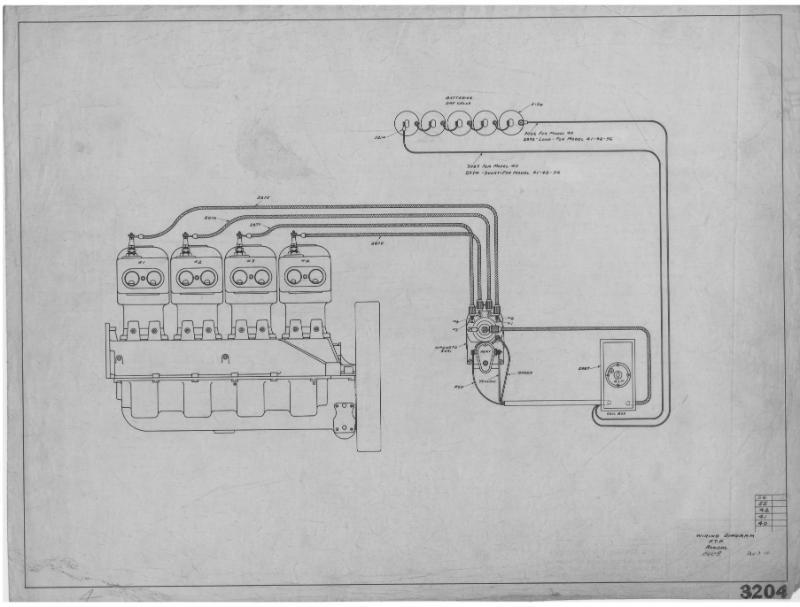
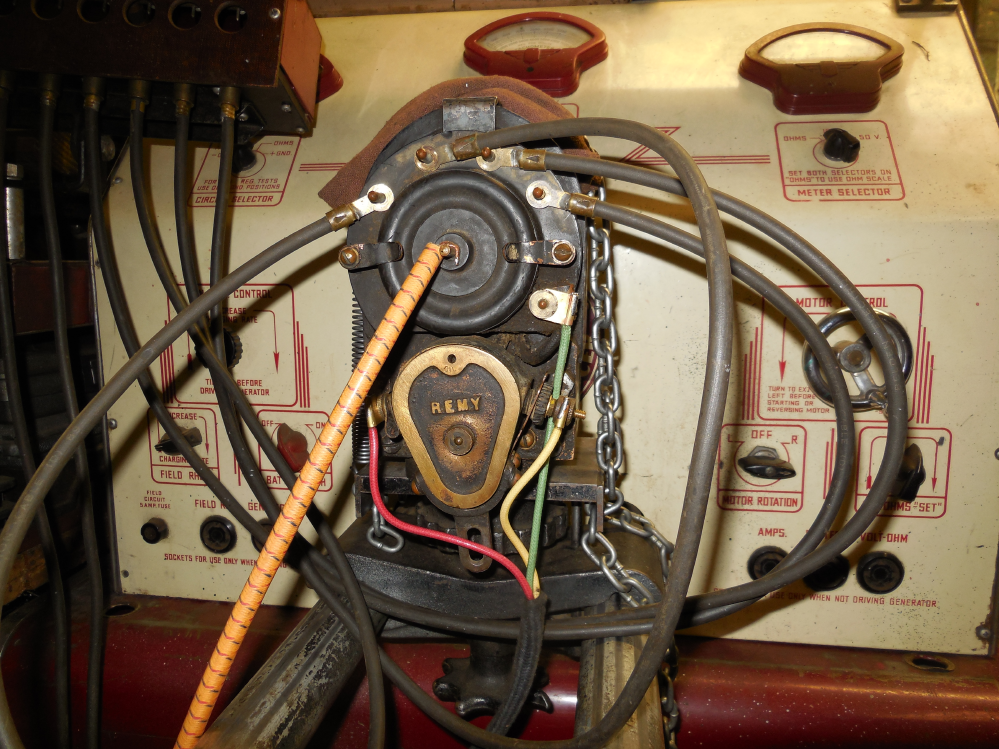
Here is the magneto connection up close and personal. Fortunately, Remy used the same wire colours and connections for different magnetos. The red wire goes to the magneto chassis and serves as a ground. The location of the magneto ground(Chassis) connection varies with some models but serves the same purpose. The green wire is the hot wire from the magneto. It is where the connection is made to the centrally mounted low tension winding.The other end of the low tension winding is grounded to the magneto chassis. The yellow wire connects to the breaker terminal. Some magnetos( Model RL) have the condenser mounted in the coil box and others gave the condenser mounted on the magneto under the arch of the magnets. These are nearly always bad. Almost any automotive condenser rated at 0.2Microfarad will work. The high tension wire from the coilbox is a 7 or 9MM and connects to the center of the cap to feed the distributor rotor.
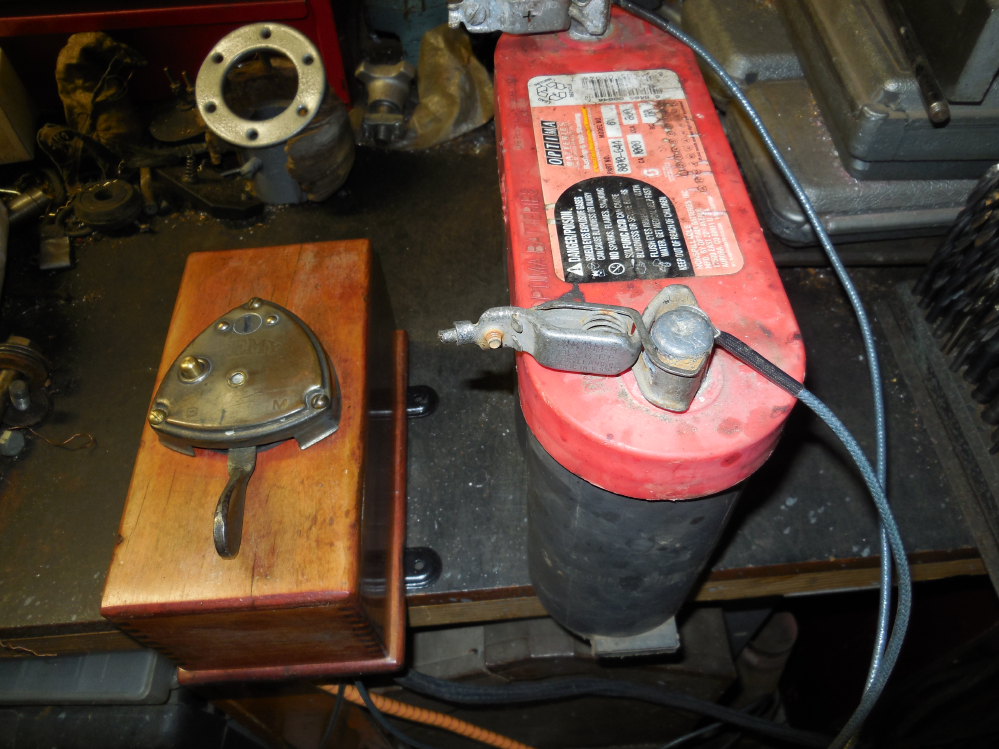
The coil and kick switch are shown here. The button on the left id for starting when the engine is rolled past top center and primed. The two black wires coming from the coil connect to the bank of dry cells for starting. We are using a 6 volt battery for starting but for sanity's sake, the coil operates on 3-4 volts. In the battery starting mode the battery current goes through a resistor before the coil to prevent damage to the coil.
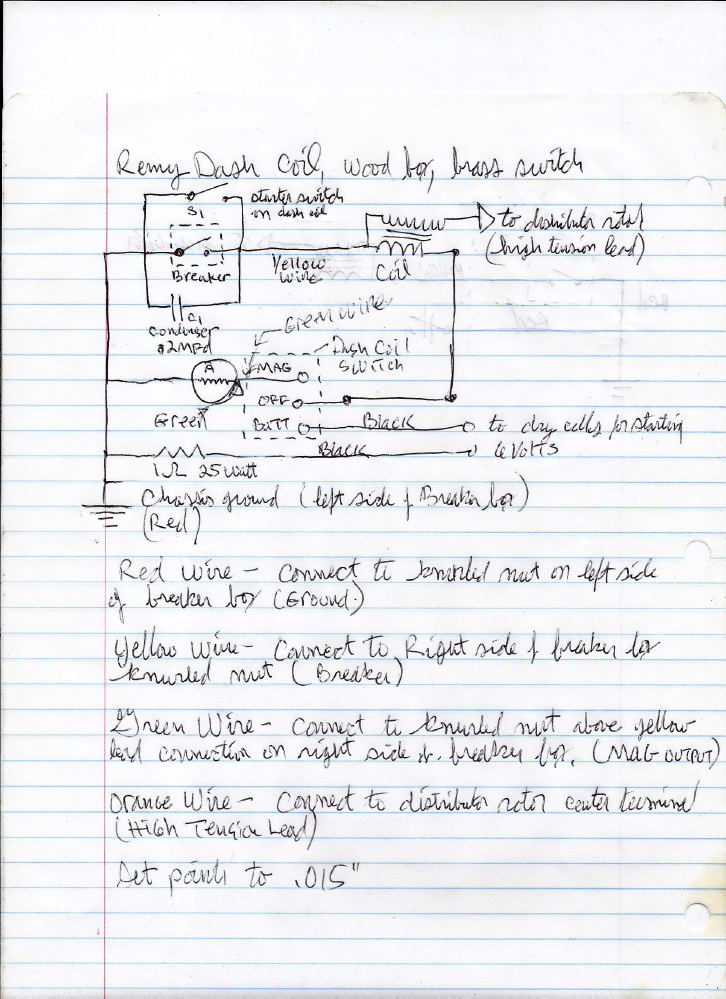
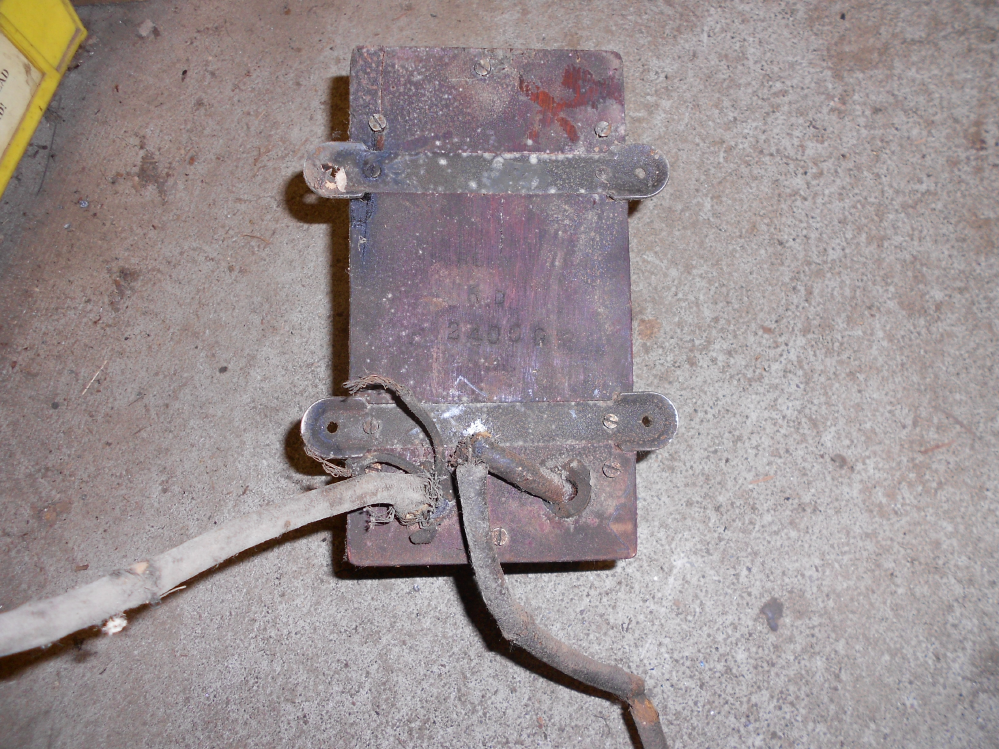
This is very typical of the harness from the coil box to the maggie. The two short wires are the black leads that connect to the dry cells for starting. The large single wire on the right is the 9MM high tension lead. The multistrand cable is typically frayed and broken. The best RX is to replace all the wiring for safety and sanity's sake.
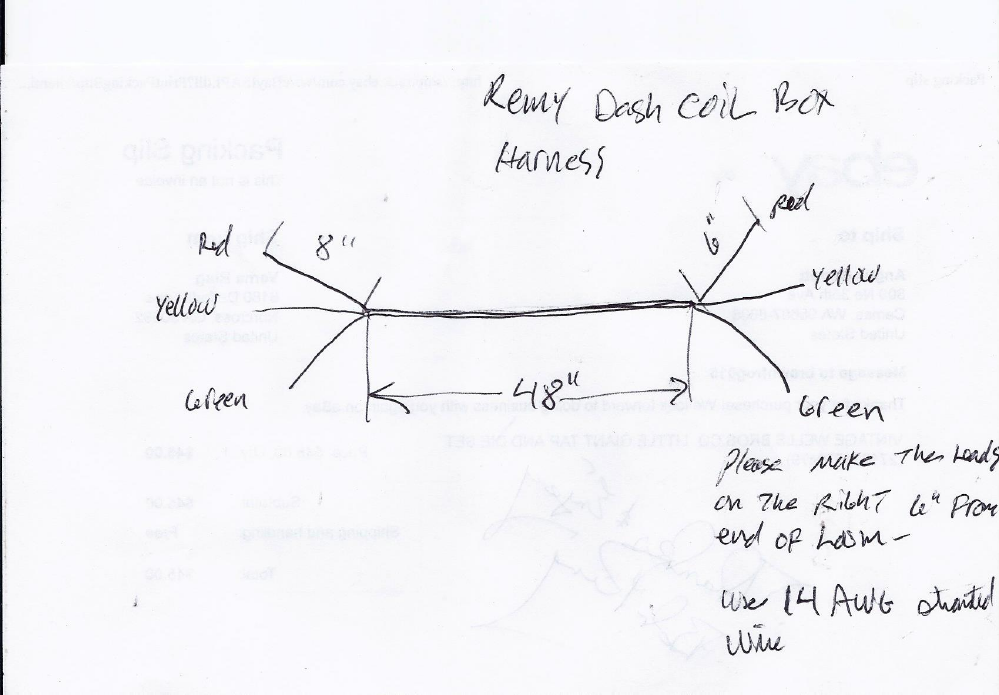
Here are the approximate dimensions of the multistranded cable. Fortunately. remy used the same colour scheme with nearly all of their low tension magnetos of the day. We have yet to find an intact battery lead to compare. If anyone does, please let us know and we will share. Also for safety, be sure and place an inline fuse in the starting battery circuit with a switch even if you are using the mag as a distributor with a separate coil and battery. YNZ's vintage parts of California made this one for us. The ends of the wires connecting to the maggie originally had flag connectors ith holes for #10 screws. We have not found a source for these yet but they can be made with shimctock or copper tape and punched for the screw size.
